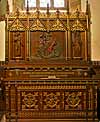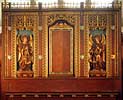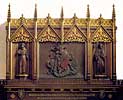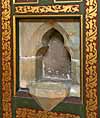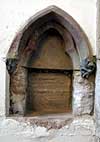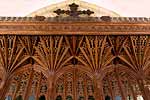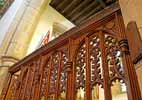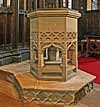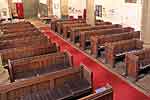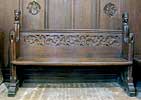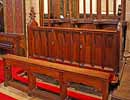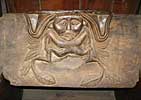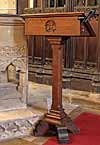For this church:    |
Strelley All SaintsFeatures and FittingsAltars
The South Transept altar was installed in 1927 when the transept was made into a memorial chapel to Frances Etheldreda Edge, wife of Thomas L K Edge, squire of Strelley. It is made of oak and richly carved with roses and lilies in a scheme of blue and gilt. Communion railsThese have no clear provenance but were very likely installed at the time of the 1855 renovation. Communion tableThe table is modern and supported on four Elizabethan bulbous fluted legs. Reredos
The chancel reredos is of carved oak, coloured and gilt, traceried and depicting angels holding censers. It was designed by the church architect C G Hare and installed in 1925 replacing an earlier one, donated by Mr and Mrs Edge in 1882. The reredos in the south transept was formerly in the chancel and was modified to fit. It is gilded, coloured and of oak. It has three carved panels surmounted by tracery and pinnacles. The centre panel shows St. George on horseback slaying the dragon. The side panels have statues of St. Francis of Assisi and St. Etheldreda the saints to whom the chapel is dedicated and the namesakes of Mrs Edge for whom the chapel is a memorial. An inscription beneath the reredos reads:
Piscina
The piscina on the south side of the chancel is 14th century: a lancet with trefoil niche above a basin with an octagonal surround. AumbreyThis is situated in the east wall of the north transept near to the chancel. It is probably 14th century and has a lancet hood mould with decorative stop and trefoil niche. The internal parts are very eroded. Rood Screen
This is probably the most impressive feature of the church. It is ogee headed with overhanging cove of tracery and made of oak. It dates from c.1490 and stands on its original stone plinth. It is believed that it was not originally built for Strelley church and that its excellent condition is due to its having been boarded up until its restoration. Its only damage is a small square cut on the south side. The rood was designed by the church architect C G Hare, in 1926, and the mortice holes from the original figures used to fix it. Other screens
The side screens at the back of the choir stalls are copies of the rood screen and were probably installed at the time of the renovations of 1855. Those to the west of the two transepts are of modern gothic and were probably installed about the time of the conversion of the south transept to a memorial chapel. All the screens are made of oak. Font
The font has a plain hexagonal bowl on a traceried stand with ogee openings. It is 14th century and in the Decorated style. Its lip has two staples for securing the wooden cover. It stands on a single step faced with quatrefoils. Churchwarden’s accounts record that, in 1855, the architect gave a quatrefoil ornament and upper step (there were two steps until 2011). From 1855 to 2011 it was positioned under the tower: early records indicate that prior to that it may have been positioned in the chancel or one of the transepts. It has some damage (repaired). In 2011 it was moved to the front and north of the rood screen to allow space for the installation of a WC under the tower. Pulpit
The pulpit is made up of four carved oak and traceried panels that stylistically date from the late 15th century. The tracery is similar to that of the Rood Screen. It is supported on a 19th century ashlar base and surmounted by a Jacobean canopy (17th century) with a carved back panel of the same period. It is one of only two pre-Reformation pulpits in Nottinghamshire and the only one remaining in use: the other is at Wysall. Reading desksThere is a plain Jacobean oak chair for the bishop. Within the chancel are two fixed reading desks which were probably installed during the renovations of 1855. Pews
During the major restoration of the church in 1855 the pews were replaced. Previously there had been box pews on either side, and at the front, of the central aisle. These were allocated to members of the congregation at vestry meetings. The outside of the pews and those of the back were for the use of ‘cottagers and strangers’. Installed were the pews in use today: although doors to the pews were discussed they were not fitted. The current pews have carved ends with quatrefoils complementing those of the font, pulpit and screens. The south transept has a pew on the west wall. A further pew within the transept may be that carved for the squire in 1855: the ends of the back have a carved head and the sides end in praying hands. Choir stalls
These were installed during the major restoration of the mid-19th century. They have moulded benches and are traceried with fleur-de-lys ends. Misericord
On each side behind the choir stalls are three stalls with misericords. These are 15th century and on the north side are two movable seats with carvings beneath. The most westerly depicts a bishop with mitre. The easterly has been described as a ‘grotesque imp’ or ‘Sheela-na-gig’: Simon Jenkins describes it as a ‘Green Woman’. Lectern It consists of a chamfered upright set on four squat semi-arched feet. The angled reading area is decorated on each side by a trefoil. |


